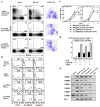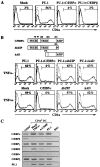Reciprocal roles for CCAAT/enhancer binding protein (C/EBP) and PU.1 transcription factors in Langerhans cell commitment
- PMID: 11877478
- PMCID: PMC2193769
- DOI: 10.1084/jem.20011465
Reciprocal roles for CCAAT/enhancer binding protein (C/EBP) and PU.1 transcription factors in Langerhans cell commitment
Abstract
Myeloid progenitor cells give rise to a variety of progenies including dendritic cells. However, the mechanism controlling the diversification of myeloid progenitors into each progeny is largely unknown. PU.1 and CCAAT/enhancing binding protein (C/EBP) family transcription factors have been characterized as key regulators for the development and function of the myeloid system. However, the roles of C/EBP transcription factors have not been fully identified because of functional redundancy among family members. Using high titer--retroviral infection, we demonstrate that a dominant-negative C/EBP completely blocked the granulocyte--macrophage commitment of human myeloid progenitors. Alternatively, Langerhans cell (LC) commitment was markedly facilitated in the absence of tumor necrosis factor (TNF)alpha, a strong inducer of LC development, whereas expression of wild-type C/EBP in myeloid progenitors promoted granulocytic differentiation, and completely inhibited TNFalpha-dependent LC development. On the other hand, expression of wild-type PU.1 in myeloid progenitors triggered LC development in the absence of TNFalpha, and its instructive effect was canceled by coexpressed C/EBP. Our findings establish reciprocal roles for C/EBP and PU.1 in LC development, and provide new insight into the molecular mechanism of LC development, which has not yet been well characterized.
Figures








Similar articles
-
Phosphorylation of PML is essential for activation of C/EBP epsilon and PU.1 to accelerate granulocytic differentiation.Leukemia. 2008 Feb;22(2):273-80. doi: 10.1038/sj.leu.2405024. Epub 2007 Nov 8. Leukemia. 2008. PMID: 17989716
-
Regulation of neutrophil and eosinophil secondary granule gene expression by transcription factors C/EBP epsilon and PU.1.Blood. 2003 Apr 15;101(8):3265-73. doi: 10.1182/blood-2002-04-1039. Epub 2002 Dec 19. Blood. 2003. PMID: 12515729
-
Granulocyte colony-stimulating factor regulates myeloid differentiation through CCAAT/enhancer-binding protein epsilon.Blood. 2001 Aug 15;98(4):897-905. doi: 10.1182/blood.v98.4.897. Blood. 2001. PMID: 11493431
-
Is PU.1 a dosage-sensitive regulator of haemopoietic lineage commitment and leukaemogenesis?Trends Immunol. 2007 Mar;28(3):108-14. doi: 10.1016/j.it.2007.01.006. Epub 2007 Jan 30. Trends Immunol. 2007. PMID: 17267285 Review.
-
Stem cell fate specification: role of master regulatory switch transcription factor PU.1 in differential hematopoiesis.Stem Cells Dev. 2005 Apr;14(2):140-52. doi: 10.1089/scd.2005.14.140. Stem Cells Dev. 2005. PMID: 15910240 Review.
Cited by
-
Langerhans Cells-Programmed by the Epidermis.Front Immunol. 2017 Nov 29;8:1676. doi: 10.3389/fimmu.2017.01676. eCollection 2017. Front Immunol. 2017. PMID: 29238347 Free PMC article. Review.
-
Analysis of PU.1/ICSBP (IRF-8) complex formation with various PU.1 mutants: molecular cloning of rat Icsbp (Irf-8) cDNA.Immunogenetics. 2005 Mar;56(12):871-7. doi: 10.1007/s00251-004-0754-2. Epub 2005 Feb 2. Immunogenetics. 2005. PMID: 15688197
-
Clonally related histiocytic/dendritic cell sarcoma and chronic lymphocytic leukemia/small lymphocytic lymphoma: a study of seven cases.Mod Pathol. 2011 Nov;24(11):1421-32. doi: 10.1038/modpathol.2011.102. Epub 2011 Jun 10. Mod Pathol. 2011. PMID: 21666687 Free PMC article.
-
RARα supports the development of Langerhans cells and langerin-expressing conventional dendritic cells.Nat Commun. 2018 Sep 25;9(1):3896. doi: 10.1038/s41467-018-06341-8. Nat Commun. 2018. PMID: 30254197 Free PMC article.
-
Transcription factors in the control of dendritic cell life cycle.Immunol Res. 2007;37(1):79-96. doi: 10.1007/BF02686091. Immunol Res. 2007. PMID: 17496348 Review.
References
-
- Metcalf, D. 1989. The molecular control of cell division, differentiation commitment and maturation in haemopoietic cells. Nature. 339:27–30. - PubMed
-
- Tenen, D.G., R. Hromas, J.D. Licht, and D.E. Zhang. 1997. Transcription factors, normal myeloid development, and leukemia. Blood. 90:489–519. - PubMed
-
- Tamura, T., T. Nagamura-Inoue, Z. Shmeltzer, T. Kuwata, and K. Ozato. 2000. ICSBP directs bipotential myeloid progenitor cells to differentiate into mature macrophages. Immunity. 13:155–165. - PubMed
-
- Passegué, E., W. Jochum, M. Schorpp-Kistner, U. Möhle-Steinlein, and E.F. Wagner. 2001. Chronic myeloid leukemia with increased granulocyte progenitors in mice lacking JunB expression in the myeloid lineage. Cell. 104:21–32. - PubMed

